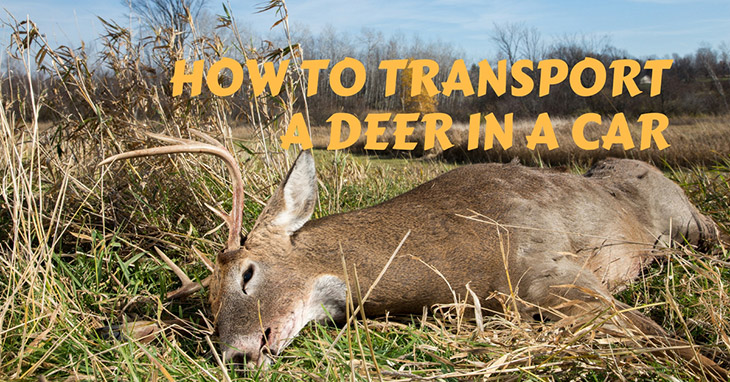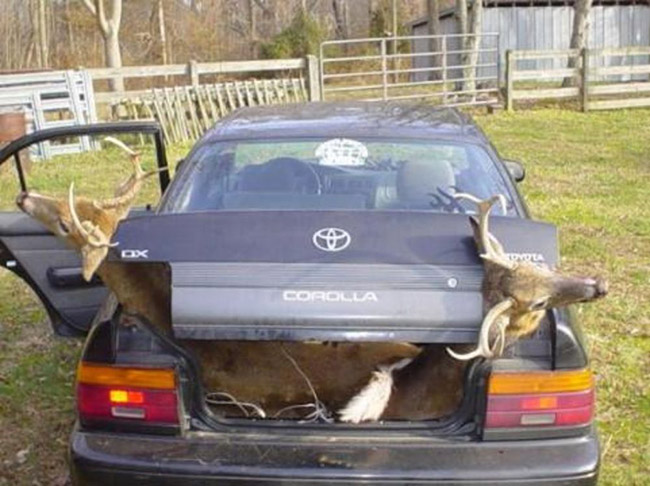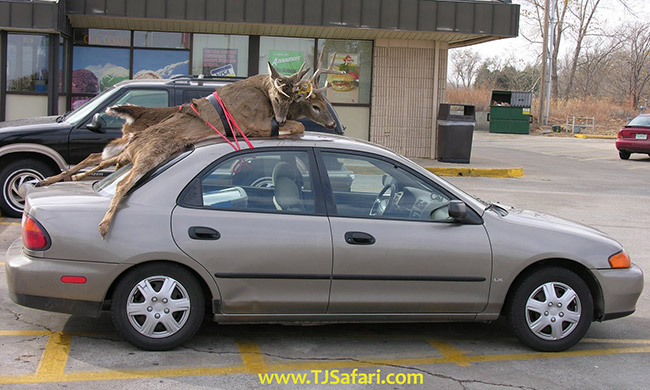Ideally, you should bring a truck during a hunt so you can easily load and transport your game from the hunting site to your next stop. However, I know that not all hunters have their own truck. There is also the chance that your truck is in for repairs during the time you have to leave for the hunt.
In either situation, you may opt to use your car to transport your deer instead. While this may not seem ideal, it may still work if you do it properly.
Today, I will share three ways on how to transport a deer in a car in case you don’t have a truck with you. Then, I will explain how to properly field-dress and cut a deer so you can store it properly in your vehicle.
Three Ways to Transport a Deer in a Car
Option 1: Pack the Deer in Your Trunk
Via outdoorlife.com
I have seen many newbie deer hunters try to stick their prize inside their car trunk and it didn’t look pretty. Doing this almost always results in the deer’s head sticking out of the trunk. You may also end up damaging some parts of your catch when the car’s hood starts whacking the deer’s neck or other body parts.
If you insist on doing it this way, you may want to consider spreading out a tarp on the trunk’s floor to keep the blood and other fluids from seeping into your trunk’s material. This doesn’t always work though and you may still end up with a smelly, blood-soaked vehicle.
Option 2: Strap It on the Roof
Via tjsafari.com
While this is technically another way to transport deer, I highly recommend against this option. In my opinion, the only thing worse than sticking your catch in your car’s trunk is strapping it onto your car’s roof. Doing this exposes your deer to elements that might affect the quality of its meat.
Again, if you wish to do it this way, line up your car’s roof with tarp and strap in your deer with heavy-duty rope or cord. Be prepared for blood dripping off your windows, as well as flies and dust contaminating your venison.
Option 3: Gut, Skin, Quarter, and Store
I recommend field-dressing and bagging your deer in the field before taking it to the game warden for recording. This not only keeps your car relatively clean and stink-free, it also prevents foreign objects or insects from damaging your deer’s carcass.
Before you start butchering, however, you may want to check with your area’s hunting commissioner on their requirements when reporting a catch. Some areas require the deer to be whole and intact when you present it for filing, so you make sure to coordinate with your local warden on the logistics first.
Steps in Deer Butchering:
Step 1: Gutting the Deer
Also called field-dressing, gutting is often the messiest of the steps because you’ll essentially be removing the blood and guts of the deer. However, it is important to slow down the growth of bacteria on the meat and reduce the carcass’s weight, too.
Use a sharp field knife, such as a fixed-blade with a non-slip handle, to carefully cut open your deer vertically from the belly upward the chest to get the internal organs out. Check out this tutorial on how to field-dress a deer in the video below:
Step 2: Skinning the Deer
I’ve tried many ways to skin a deer, and I’ve found that skinning it after hanging it upside down is the easiest way to do it. To skin your game, use a good knife set which includes a skinning knife, a gut hook, and a caping knife.
With the skinning knife, cut through the deerskin and peel the membrane away carefully. Use the gut hook to cut around joints and hard corners and the caping knife if you want to shoulder cape your deer for mounting on your wall as a trophy.
For more details on how to skin a deer, see this video below:
Step 3: Quartering the Deer
You don’t have to be an anatomy expert to know how to quarter a deer properly. Just take some time to know the basics; this may help you cut your deer into proper cuts efficiently.
Avoid using a saw to cut away the bones because this may cause bone fragments to pierce the meat. Instead, sharpen your field knife with a reliable knife sharpener and use it to slice away the muscles and separate the joints.
Here’s a detailed tutorial of how to quarter a deer:
Step 4: Store the Cut Meat
Now that the hard part is done, it’s time to store your cut parts. Instead of simply bagging the meat, you may want to store them in a cooler filled with ice or any other appropriate storage container.
The ideal temperature for storing venison is 32 to 40 degrees. Seal your meat cuts in separate ziplock bags and immediately place them in the cooler to avoid the growth of bacteria that may cause meat spoilage.
Things to Remember Before Transporting a Deer
1. Make Sure All Car Parts are Working Properly
Car troubles are not uncommon during hunting trips, so you may want to take the time to double check your vehicle before heading out for the hunting grounds.
If your car breaks down in the middle of a deer transport, there’s a chance that your venison may go bad or the quality may be affected. Not only will this be a waste of good meat, you will also waste the time and effort you spent during your hunt.
“List of Auto Parts That You Should Know Before Driving a Car” gives a list of car parts you should check before that hunting trip. While the battery and brakes may seem to be the most important, you should still take the time to check other parts and make sure they are working properly.
2. Check Tools for Butchering the Deer
Make a list of all necessary tools and equipment for dressing and quartering a deer and then check that you have all of them. You don’t want to lay down your deer on a tarp to start butchering only to discover that you forgot your field knife at home.
Other materials, like hand wipes or knife sharpeners, may not seem as important at first, but you may be surprised how much you wish you’d brought them when you find yourself with bloody hands or a dull skinning knife that couldn’t cut through your deer’s skin.
Conclusion
While placing the deer in your car’s trunk or strapping it onto your roof are valid options, I recommend butchering your prize on site and storing it in a cooler for easy transport. Just make sure you have a sharp and reliable set of field knives to make the job easy for you.
Do you have comments or other quick tips on how to transport a deer? Leave them in the comments’ section below. Happy hunting!



